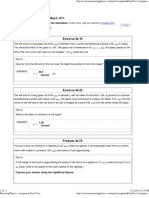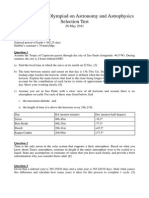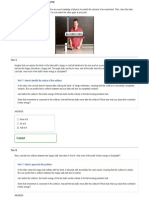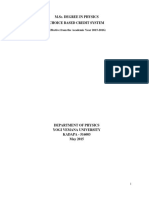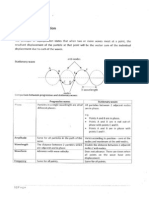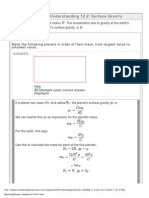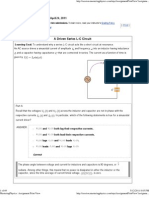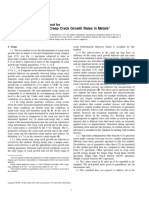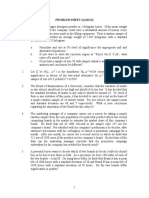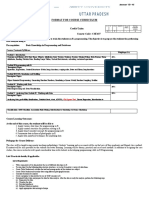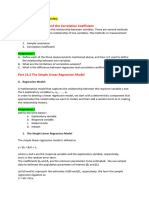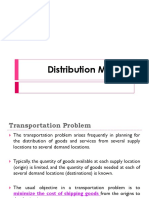23
23
Uploaded by
physicsdocsCopyright:
Available Formats
23
23
Uploaded by
physicsdocsCopyright
Available Formats
Share this document
Did you find this document useful?
Is this content inappropriate?
Copyright:
Available Formats
23
23
Uploaded by
physicsdocsCopyright:
Available Formats
MasteringPhysics: Assignment Print View
http://session.masteringphysics.com/myct/assignmentPrintView?assignme...
Homework 3
Due: 11:59pm on Thursday, March 10, 2011
Note: You will receive no credit for late submissions. To learn more, read your instructor's Grading Policy [Switch to Standard Assignment View]
Electric Field Due to Increasing Flux
Learning Goal: To work through a straightforward application of Faraday's law to find the EMF and the electric field surrounding a region of increasing flux Faraday's law describes how electric fields and electromotive forces are generated from changing magnetic fields. This problem is a prototypical example in which an increasing magnetic flux generates a finite line integral of the electric field around a closed loop that surrounds the changing magnetic flux through a surface bounded by that loop. A cylindrical iron rod with cross-sectional area is oriented with its symmetry axis coincident with the z axis of a cylindrical coordinate system as shown. It has a uniform magnetic field inside that varies according to . In other words, the magentic field is always in the positive z direction, and it has no other components. For your convenience, we restate Faraday's law here: , where is the line integral of the electric field, and the magnetic flux is given by , where is
the angle between the magnetic field and the local normal to the surface bounded by the closed loop. Direction: The line integral and surface integral reverse their signs if the reference direction of or is reversed. The right-hand rule applies here: If the thumb of your right hand is taken along , then the fingers point along . You are free to take the loop anywhere you choose, although usually it makes sense
to choose it to lie along the path of the circuit you are considering. Part A Find , the electromotive force (EMF) around a loop that is at distance from the z axis, where is
restricted to the region outside the iron rod as shown. Take the direction shown in the figure as positive. Hint A.1 Selecting the loop Hint not displayed Hint A.2 Find the magnetic flux Hint not displayed Express in terms of , , , , and any needed constants such as , , and .
1 of 44
5/12/2011 8:02 PM
MasteringPhysics: Assignment Print View
http://session.masteringphysics.com/myct/assignmentPrintView?assignme...
ANSWER:
= Correct
Part B Due to the cylindrical symmetry of this problem, the induced electric field distance Hint B.1 from the z axis, where can depend only on the
is restricted to the region outside the iron rod. Find this field.
Calculate the line integral Hint not displayed
Hint B.2
The z and r components of the electric field Hint not displayed
Express
in terms of quantities given in the introduction (and constants), using the unit
vectors in the cylindrical coordinate system, , , and . ANSWER: = Correct
Introduction to Faraday's Law
Learning Goal: To understand the terms in Faraday's law for magnetic induction of electric fields, and contrast these fields with those produced by static charges. Faraday's law describes how electric fields and electromotive forces are generated from changing magnetic fields. It relates the line integral of the electric field around a closed loop to the change in the total magnetic field integral across a surface bounded by that loop: , where is the line integral of the electric field, and the magnetic flux is given by , where is the angle between the magnetic field and the local normal to the surface bounded by the closed
loop. Direction: The line integral and surface integral reverse their signs if the reference direction of or is reversed. The right-hand rule applies here: If the thumb of your right hand points along , then the fingers point along . You are free to take the loop
2 of 44
5/12/2011 8:02 PM
MasteringPhysics: Assignment Print View
http://session.masteringphysics.com/myct/assignmentPrintView?assignme...
anywhere you choose, although usually it makes sense to choose it to lie along the path of the circuit you are considering.
Part A Consider the direction of the electric field in the figure. Assume that the magnetic field points upward, as shown. Under what circumstances is the direction of the electric field shown in the figure correct? Hint A.1 How to approach the problem Hint not displayed
ANSWER:
always if if increases with time decreases with time
depending on whether your right thumb is pointing up or down Correct
Part B Now consider the magnetic flux through a surface bounded by the loop. Which of the following statements about this surface must be true if you want to use Faraday's law to relate the magnetic flux to the line integral of the electric field around the loop? ANSWER:
The surface must be the circular disk in the middle of the loop. The surface must be perpendicular to the magnetic field at each point. The surface can be any surface whose edge is the loop. The surface can be any surface whose edge is the loop as long as no magnetic field line passes through it more than once. Correct
You are free to take any surface bounded by the loop as the surface over which to evaluate the integral. The result will always be the same, owing to the continuity of magnetic field lines (they never start or end anywhere, since there are no magnetic charges). It is important to understand the vast differences between electric fields produced by changing magnetic fields via Faraday's law and the more familiar electric fields produced by charges via Coulomb's law. Here are some short questions that illustrate these differences. Part C
3 of 44
5/12/2011 8:02 PM
MasteringPhysics: Assignment Print View
http://session.masteringphysics.com/myct/assignmentPrintView?assignme...
When can an electric field be measured at any point from the force on a stationary test charge at that point? Hint C.1 Force on a stationary charge Hint not displayed
ANSWER:
only if the field is generated by the coulomb field of static charges only if the field is generated by a changing magnetic field no matter how the field is generated Correct
In fact, this operation defines an electric field. Similarly, if the test charge is moving, it will measure magnetic fields.
Part D When can an electric field that does not vary in time arise? ANSWER:
only if the field is generated by a coulomb field of static charges only if the field is generated by a changing magnetic field in either of the above two cases Electric fields never vary in time; otherwise, a charge could gain energy from the field. Correct
Part E When will the integral be zero? ANSWER: around any closed loop of the projection of the electric field along that loop
only if the field is generated by the coulomb field of static charges only if the field is generated by the coulomb field of static charges or a constant current only if the field is generated by a changing magnetic field however the field is generated The loop integral is always zero; otherwise, a charge moving around the loop would gain energy. Correct
4 of 44
5/12/2011 8:02 PM
MasteringPhysics: Assignment Print View
http://session.masteringphysics.com/myct/assignmentPrintView?assignme...
The electric field generated by a static charge or a constant current always has zero loop integral. A constant current is a continuous line of evenly-spaced charges moving with constant velocity. An electric field generated by any other configuration of moving charges (moving through the loop) would have a non-zero loop integral. Here is a simple quantitative problem that uses Faraday's law. Part F A cylindrical iron rod of infinite length with cross-sectional area is oriented with its axis of symmetry
coincident with the z axis of a cylindrical coordinate system as shown in the figure. It has a magnetic field inside that varies according to . Find the theta component of the electric field at distance from the z axis, where is larger than the radius of the rod.
Hint F.1
Selecting the loop Hint not displayed
Hint F.2
Find the magnetic flux Hint not displayed
Hint F.3
Finding the EMF from Faraday's law Hint not displayed
Hint F.4
Help from symmetry Hint not displayed
Hint F.5
Find the EMF in terms of Hint not displayed
Express your answer in terms of
, and any needed constants such as
, and
5 of 44
5/12/2011 8:02 PM
MasteringPhysics: Assignment Print View
http://session.masteringphysics.com/myct/assignmentPrintView?assignme...
ANSWER: = Correct
A Simple Way to Measure Magnetic Fields
A loop of wire is at the edge of a region of space containing a uniform magnetic field . The plane of the loop
is perpendicular to the magnetic field. Now the loop is pulled out of this region in such a way that the area of the coil inside the magnetic field region is decreasing at the constant rate . That is, , with .
Part A The induced emf in the loop is measured to be loop was in? Hint A.1 The formula for the magnetic flux through a loop Hint not displayed Hint A.2 How to take the derivative of the product of two functions Hint not displayed Hint A.3 The formula for the emf induced in a loop (Faraday's law) Hint not displayed Express your answer in terms of some or all of the variables ANSWER: = Correct , , and . . What is the magnitude of the magnetic field that the
So you see that in general, there can be contributions to the induced emf in a wire loop both from a changing magnetic field through the loop (about which you may have studied earlier) and from the change in the area of the loop (within the magnetic field region), as in this problem.
Part B For the case of a square loop of side length being pulled out of the magnetic field with constant speed ?
(see the figure), what is the rate of change of area
6 of 44
5/12/2011 8:02 PM
MasteringPhysics: Assignment Print View
http://session.masteringphysics.com/myct/assignmentPrintView?assignme...
Hint B.1
How to approach the problem Hint not displayed
Express your answer in terms of ANSWER: = Correct
and .
Later, you will learn, if you have not already, that the "motional emf" moving through a uniform magnetic field of magnitude , or, equivalently, . with speed
associated with a rod of length is given by
This is another way of thinking about the result derived above. If you have already studied this, can you see which sides of the square loop contribute to the motional emf and which do not, and why?
Motion-Induced Electric Fields and Motional EMF
Learning Goal: To understand that the motion of a conductor through a magnetic field generates a perpendicular electric field.
A conducting rod of length
is moved at a constant velocity
through a uniform magnetic field
. This
7 of 44
5/12/2011 8:02 PM
MasteringPhysics: Assignment Print View
http://session.masteringphysics.com/myct/assignmentPrintView?assignme...
field runs perpendicularly out of the page. The end of the rod at is labeled b. Part A
is labeled a, and the end of the rod at
As a result of the motion through the magnetic field, a charge in the rod will experience a force : the usual part of the Lorentz force for charges moving through magnetic fields. This force will push the charge in the rod, and hence this force will be an electromotive force (EMF). For now, we shall say that the force that moves the charges is due to an induced electric field , which will enable us to calculate the EMF. The fact that there is an induced electric field at all is rather subtle, because there is no closed loop that encloses some changing flux. Therefore, a method that does not involve Faraday's law must be used to solve this motional EMF problem. In fact, this problem is a good introduction to some of the ideas behind Faraday's law. Find the y component of the induced electric field . Hint A.1 Find the force on a charge due to motion in the magnetic field Hint not displayed Hint A.2 Find an equivalent electric field Hint not displayed Express your answer in terms of the variables given in the problem introduction. ANSWER: = Correct
Part B To describe the effect of this electric field on the rod, we need to find the EMF . We take as a reference
direction the path from end a to end b (i.e., moving along the positive y axis). The EMF is then negative if the induced electric field points in the direction (i.e., like a battery with the positive voltage end at a, where the positive charge collects due to the magnetic force on the charges). Hint B.1 What is EMF? Hint not displayed Express your answer in terms of the variables given in the problem introduction. ANSWER: = Correct
Part C There is a big complication in measuring the EMF generated by the moving rod: The wires that connect the meter to the rod also move through the magnetic field, and therefore, there is an electromotive force for them also. This is a general problem: A voltmeter can measure the EMF produced only in a closed loop around the circuit. In general, the EMF caused by the motion of a rod through a uniform magnetic field will be canceled by the opposite EMF induced by the motion of the rest of the circuit through this same uniform
8 of 44
5/12/2011 8:02 PM
MasteringPhysics: Assignment Print View
http://session.masteringphysics.com/myct/assignmentPrintView?assignme...
field. The only way to get a nonzero voltmeter reading is to make the field nonuniform, for example, such that the bar is moving through a region of nonzero field, but the rest of the circuit is (temporarily) moving in a region of zero field. For example, consider the arrangement shown in the figure for measuring the EMF in the moving rod using a voltmeter. In this arrangement, only for and . The hookup wires and voltmeter will have to move with the rod; they are rigid and of the dimensions and shape shown. The physical setup is that shown at the end of Part B. Which graph shown best represents the magnitude of that will be measured by the voltmeter? Take moment pictured in the diagram. to be the
Hint C.1
How to approach the problem Hint not displayed
Hint C.2
Describe the EMF when only the rod moves through the field Hint not displayed
Hint C.3
Describe the EMF when the whole circuit is moving through the field Hint not displayed
ANSWER:
a b c d
9 of 44
5/12/2011 8:02 PM
MasteringPhysics: Assignment Print View
http://session.masteringphysics.com/myct/assignmentPrintView?assignme...
e Correct
Part D Is the sign of positive or negative? If current flows through the meter from positive to negative, then it
will read a positive voltage. Hint D.1 Which way is the magnetic force pushing the charge? Hint not displayed
ANSWER:
positive negative Correct
It makes little sense to discuss only the EMF generated in the rod. How the wires connect the voltmeter to the rod is important, too, because they may move through the field (or the field lines may move across them). The crucial realization (by Michael Faraday) is that EMF is really a property of an entire closed circuit.
Induced EMF and Current in a Shrinking Loop
Shrinking Loop. A circular loop of flexible iron wire has an initial circumference of 164 circumference is decreasing at a constant rate of 14.0 in a constant uniform magnetic field of magnitude 1.00 , but its due to a tangential pull on the wire. The loop is , which is oriented perpendicular to the plane of the
loop. Assume that you are facing the loop and that the magnetic field points into the loop. Part A Find the magnitude of the emf induced in the loop after exactly time 5.00 has passed since the
circumference of the loop started to decrease. Hint A.1 How to approach the problem Hint not displayed Hint A.2 An expression for the circumference of the loop as a function of time Hint not displayed Hint A.3 An expression for the flux through the loop as a function of its circumference Hint not displayed
10 of 44
5/12/2011 8:02 PM
MasteringPhysics: Assignment Print View
http://session.masteringphysics.com/myct/assignmentPrintView?assignme...
Hint A.4
A formula for the induced emf in the loop (Faraday's law) Hint not displayed
Hint A.5
An expression for Hint not displayed
Express your answer numerically in volts to three significant figures. ANSWER:
2 = 2.0910 V Correct
Part B Find the direction of the induced current in the loop as viewed looking along the direction of the magnetic field. ANSWER:
clockwise counterclockwise Correct
The induced current flows in the direction that tends to prevent the flux through the coil from decreasing. That is, it adds to the magnetic field through the coil as the coil's area is decreasing. This means that the current has to flow clockwise, so that the magnetic field produced by it (right-hand rule) points away from you (you were asked to look at the loop along the direction of the original magnetic field). Alternatively, you could look at how each part of the wire moves toward the center of the loop as it gets smaller. As a result, we can use the standard equation for force on a particle and the right-hand rule to determine the direction of the current.
An Introduction to EMF and Circuits
Learning Goal: To understand the concept of electromotive force and internal resistance; to understand the processes in one-loop circuits; to become familiar with the use of the ammeter and voltmeter. In order for the current in a conductor to exist continuously, the conductor must be part of a loop, that is, a closed path through which the charged particles can move without creating a "build-up." Such build-up, if it occurs, creates its own electric field that cancels out the external electric field, ultimately causing the current to stop. However, having a loop, or a closed circuit, is not enough to maintain the current; there must also be a source of energy. Its necessity is fairly obvious: As charged particles move along the circuit, they lose potential energy. In fact, electrostatic forces always push the particles in the direction that leads to a decrease in potential energy. At some point, each charged particle would reach the location in the circuit where it has the lowest possible potential energy. How can such a particle move toward a point where it would have a higher potential energy? Such a move requires that nonelectrostatic forces act upon the charged particle, pushing it toward higher potential energy despite the presence of electrostatic forces. In circuits, such forces exist inside a device
11 of 44
5/12/2011 8:02 PM
MasteringPhysics: Assignment Print View
http://session.masteringphysics.com/myct/assignmentPrintView?assignme...
commonly known as a battery. In a circuit, the battery serves as the energy source that keeps the charged particles in continuous motion by increasing their potential energy through the action of some kind of nonelectrostatic force. The amount of work that the battery does on each coulomb of charge that it "pushes through" is called (inappropriately) the electromotive force (pronounced "ee-em-ef" and abbreviated emf or denoted by ). Batteries are often referred to as sources of emf (rather than sources of energy, even though they are, fundamentally, sources of energy). The emf of a battery can be calculated using the definition mentioned above: . The units of emf are joules per coulomb, that is, volts. The terminals of a battery are often labeled and for "higher potential" and "lower potential," respectively.
The potential difference between the terminals is called the terminal voltage of the battery. If no current is running through a battery, the terminal voltage is equal to the emf of the battery: . However, if there is a current in the circuit, the terminal voltage is less than the emf because the battery has its own internal resistance (usually labeled ). When charge passes through the battery, the battery does the amount of work on the charge; however, the charge also "loses" the amount of energy equal to , and the terminal ( is the current through the circuit); therefore, the increase in potential energy is voltage is . In order to answer the questions that follow, you should first review the meaning of the symbols describing various elements of the circuit, including the ammeter and the voltmeter; you should also know the way the ammeter and the voltmeter must be connected to the rest of the circuit in order to function properly. Note that the internal resistance is usually indicated as a separate resistor drawn next to the "battery" symbol. It is important to keep in mind that this resistor with resistance is actually inside the battery. In all diagrams, stands for emf, for the internal resistance of the battery, and for the resistance of the external circuit. As usual, we'll assume that the connecting wires have negligible resistance. We will also assume that both the ammeter and the voltmeter are ideal: That is, the ammeter has negligible resistance, and the voltmeter has a very large resistance. Part A For the circuit shown in the diagram , which potential difference corresponds to the terminal voltage of the battery?
ANSWER:
between points K and L between points L and M between points K and M Correct
12 of 44
5/12/2011 8:02 PM
MasteringPhysics: Assignment Print View
http://session.masteringphysics.com/myct/assignmentPrintView?assignme...
Keep in mind that the "resistor" with resistance
is actually inside the battery.
The next several questions refer to the four diagrams shown here labeled A, B, C, and D.
Part B In which diagram(s) (labeled A - D) does the ammeter correctly measure the current through the battery? Hint B.1 How an ammeter works Hint not displayed Enter the letter(s) of the correct diagram(s) in alphabetical order. For example if both A and C are correct enter AC. ANSWER: CD Correct
Part C In which diagram is the current through the battery nearly zero? Hint C.1 How to approach the problem Hint not displayed
ANSWER:
A B C D Correct
Diagram A is the only one in which the current through the battery is the same as the current through
13 of 44
5/12/2011 8:02 PM
MasteringPhysics: Assignment Print View
http://session.masteringphysics.com/myct/assignmentPrintView?assignme...
the voltmeter. Since the latter has a very large resistance, this current is essentially zero.
Part D In which diagram or diagrams does the ammeter correctly measure the current through the resistor with resistance ? Hint D.1 How to approach the problem
Note that current is conserved through a wire, and in order for an ammeter to measure the correct current passing through an element, it must be in series with that element. Enter the letter(s) of the correct diagram(s) in alphabetical order. For example if both A and C are correct enter AC. ANSWER: CD Correct
Part E In which diagram does the voltmeter correctly measure the terminal voltage of the battery? Choose the best answer. Hint E.1 How a voltmeter works Hint not displayed
ANSWER:
A B C D Correct
In diagrams A and B, the voltmeter readings would actually be quite close to the terminal voltage if the ammeter has a very low resistance, and the voltmeter, a very high one. However, diagram C clearly shows the best way to connect the voltmeter in order to measure the terminal voltage.
Part F In which diagram does the voltmeter read almost zero? Enter the letter(s) of the correct diagram(s) in alphabetical order. For example if both A and C are correct enter AC. ANSWER: D Correct
The voltmeter in diagram D is connected to two points that are also connected by a wire that has,
14 of 44
5/12/2011 8:02 PM
MasteringPhysics: Assignment Print View
http://session.masteringphysics.com/myct/assignmentPrintView?assignme...
presumably, very low resistance. Therefore, the charge flowing through that wire will not lose an appreciable amount of potential energy, and the potential difference (voltage) is nearly zero.
Part G In which diagram or diagrams does the ammeter read almost zero? Enter the letter(s) of the correct diagram(s) in alphabetical order. For example if both A and C are correct enter AC. ANSWER: AB Correct
In diagram A, the voltmeter is connected in series with the battery. Since the voltmeter has a very large resistance there is no (or nearly zero) current in the whole circuit. Therefore, the ammeter reads no current. In diagram B, the current through the ammeter is the same as the current through the voltmeter. Since the resistance of the voltmeter is very large, the current is nearly zero. The last group of questions refers to a battery that has emf 12.0 volts and internal resistance 3.00 ohms. Part H A voltmeter is connected to the terminals of the battery; the battery is not connected to any other external circuit elements. What is the reading of the voltmeter ? Express your answer in volts. Use three significant figures. ANSWER: = 12.0 Correct
Part I The voltmeter is now removed and a 21.0-ohm resistor is connected to the terminals of the battery. What is the current through the battery? Express your answer in amperes. Use two significant figures. ANSWER: = 0.50 Correct
Part J In the situation described in Part I, what is the current through the 21.0-ohm resistor?
Express your answer in amperes. Use two significant figures. ANSWER: = 0.50 Correct
Since the battery and the external resistor form one loop, the charge that passes through one must
15 of 44
5/12/2011 8:02 PM
MasteringPhysics: Assignment Print View
http://session.masteringphysics.com/myct/assignmentPrintView?assignme...
pass through another; therefore, the currents must be the same.
Part K What is the potential difference Hint K.1 across the 21.0-ohm resistor from Part I?
How to approach the problem across a resistor when a current is flowing is to use
The best way to find the potential difference Ohm's law:
Express your answer in volts. Use three significant figures. ANSWER: = 10.5 Correct
Part L What is the terminal voltage Hint L.1 of the battery connected to the 21.0-ohm resistor from Part I?
Kirchhoff's voltage law
Kirchhoff's voltage law states that the voltage difference across all the elements in a circuit (in this case just one resistor) is equal to the voltage at the terminals from the source (in this case a battery). Express your answer in volts. Use three significant figures. ANSWER: = 10.5 Correct
Since the ends of the resistor with resistance
are attached to the terminals of the battery, the
voltage across the resistor is the same as that between the terminals of the battery.
Part M How much work Hint M.1 does the battery connected to the 21.0-ohm resistor perform in one minute?
How to approach the problem
Find the charge that passes through the battery, and then use the definition of emf. Hint M.2 Find the charge passes through the battery in one minute?
How much charge
Hint M.2.1 Definition of current
16 of 44
5/12/2011 8:02 PM
MasteringPhysics: Assignment Print View
http://session.masteringphysics.com/myct/assignmentPrintView?assignme...
Recall that current is defined as the number of units of charge that pass through a wire per second. Express your answer in coulombs. Use three significant figures. ANSWER: = 30.0 Answer Requested
Express your answer in joules. Use three significant figures. ANSWER: = 360 Answer Requested
A Few Bumps on the Road
Learning Goal: To learn to apply the microscopic theory of conduction. A gauge-12 wire has diameter centimeters and length meters. When the voltage amperes. The concentration of free volts is applied to the ends of the wire, the current is electrons in the wire is Part A Find the resistivity Hint A.1 of the wire. per cubic meter.
How to approach the problem
Find the electric field and the current density in the wire and use those to calculate the resistivity. Hint A.2 Definition of resistivity of a material is given by the ratio of the electric field that then flows through it: . applied to the material and the
The resistivity current density
Hint A.3
What is the current density? flowing through the wire.
Find the current density
Hint A.3.1 Definition of current density The current density flowing through a material is given by , where is the total current and
is the cross-sectional area in which the current flows.
Hint A.3.2 Find the cross-sectional area What is the cross-sectional area of the wire?
17 of 44
5/12/2011 8:02 PM
MasteringPhysics: Assignment Print View
http://session.masteringphysics.com/myct/assignmentPrintView?assignme...
Express your answer in square meters. Use three significant figures. ANSWER:
6 = 3.3010 All attempts used; correct answer displayed
Express your answer in amperes per square meter. ANSWER:
6 = 7.2710 Correct
Hint A.4
What is the electric field? along the wire.
Calculate the electric field
Hint A.4.1 Definition of electric field In a conducting wire, the electric field potential difference is constant along the wire, so the electric field is just the : .
between the ends of the wire divided by the length of the wire
Express your answer in volts per meter. ANSWER: = 0.200 Correct
Express your answer in ohm-meters. Use two significant figures. ANSWER:
8 = 2.7510 Correct
Part B Find the mean time Hint B.1 between electron collisions in the wire.
How to approach the problem between collisions, use the fact that the average velocity of an electron is given by .
In order to find the mean time
in the presence of an electric field
One can then use the definition of the current density
and the resistivity
to determine the value of .
Hint B.2
Definition of current density
18 of 44
5/12/2011 8:02 PM
MasteringPhysics: Assignment Print View
http://session.masteringphysics.com/myct/assignmentPrintView?assignme...
Recall that current density
can be defined as
, where
is the number of free electrons in
the material, is the electric charge on each electron, and is the drift velocity of all the electrons (average velocity at which they move as a collection of particles). Hint B.3 Definition of resistivity is defined as , where is the applied electric field and is the resulting current density. Use this definition and the between collisions.
Recall that resistivity
previous hints to determine the mean time
Express your answer in seconds. Use two significant figures. ANSWER:
14 = 2.2010 All attempts used; correct answer displayed
A Five Wire Junction
Learning Goal: To learn to apply the concept of current density and Kirchhoff's junction rule. Consider a junction of five wires, as shown in the figure. The arrows indicate the direction of current flow.
The information about the magnitudes of the current density and the diameters for wires 1, 2, 3, and 4 is given in the table. Some of the values are unknown. ) Diameter ( ) Total Current ( ) Wire Current density ( 1 2 3 4 1.6 ??? 3.0 0.8 2.0 3.0 1.1 ??? ??? 2.0 ??? 4.0
Part A
19 of 44
5/12/2011 8:02 PM
MasteringPhysics: Assignment Print View
http://session.masteringphysics.com/myct/assignmentPrintView?assignme...
Find the current Hint A.1
in wire 5.
How to approach the problem Hint not displayed
Hint A.2
Kirchhoff's rule Hint not displayed
Hint A.3
Current density and current Hint not displayed
Hint A.4
Area of the wire Hint not displayed
Express your answer in amperes. Use two significant figures. Assume that the current out of the junction is positive and that the current into the junction is negative. ANSWER: = -9.9 Correct
Note that you did not have to find all the unknown quantities in the table. Separating useful information from the useless (irrelevant) is an important skill that you are expected to develop in studying physics.
A Stretchable Resistor
A wire of length Part A What will be the resistance of the wire if it is stretched to twice its original length? Assume that and cross-sectional area has resistance .
the density and resistivity of the material do not change when the wire is stretched. Hint A.1 Formula for the resistance of a wire Hint not displayed Hint A.2 Find the cross-sectional area of the stretched wire Hint not displayed Express your answer in terms of the wire's original resistance ANSWER: .
= Correct
20 of 44
5/12/2011 8:02 PM
MasteringPhysics: Assignment Print View
http://session.masteringphysics.com/myct/assignmentPrintView?assignme...
Current and Current Density at a Junction
Consider the juncion of three wires as shown in the diagram.
The magnitudes of the current density and the diameters for wires 1 and 2 are given in the table. The current directions are indicated by the arrows. Current density Diameter Wire ( ) ( ) 1 2 Part A Find the current Hint A.1 in wire 3. 3.0 5.0 2.0 3.0
How to approach the problem Hint not displayed
Hint A.2
Kirchhoff's rule Hint not displayed
Hint A.3
Current density and current Hint not displayed
Hint A.4
Area of the wire Hint not displayed
Express your answer in amperes to two significant figures. Call current out of the junction positive and current into the junction negative. ANSWER: = -26 Correct
Part B
21 of 44
5/12/2011 8:02 PM
MasteringPhysics: Assignment Print View
http://session.masteringphysics.com/myct/assignmentPrintView?assignme...
Find the magnitude of the current density Hint B.1 Current density and current
in wire 3. The diameter of wire 3 is 1.5 millimeters.
Hint not displayed Hint B.2 Area of the wire Hint not displayed Express your answer in amperes per square millimeter to two significant figures. ANSWER: = 15 Correct .
Down To The Wire
A current of is flowing in a typical extension cord of length . . The resisitivity of copper is . . The . The cord is made of copper wire with diameter The charge of the electron is concentration of free electrons in copper is Part A Find the drift velocity Hint A.1 of the electrons in the wire.
Find the current density first Hint not displayed
Hint A.2
Current density and the drift speed Hint not displayed
Express your answer in meters per second, to two significant figures. ANSWER:
4 = 3.3010 Correct
Note that this wire is carrying more current density than is carried by most household wiring in everyday use. With the given amount of current flowing, the cord would be hot to the touch if it were under a rug or had otherwise restricted air flow around it. It would certainly be considered unsafe by standard electrical safety codes. Even though this wire is carrying a large amount of current for its size, the drift velocity of the electrons is tiny (less than one millimeter per second). This reflects the fact that there is a huge number of free (mobile) electrons in the wire. Let us illustrate this fact with a calculation.
Part B
22 of 44
5/12/2011 8:02 PM
MasteringPhysics: Assignment Print View
http://session.masteringphysics.com/myct/assignmentPrintView?assignme...
The population of the Earth is roughly six billion people. If all free electrons contained in this extension cord are evenly split among the humans, how many free electrons ( ) would each person get? Hint B.1 Find the volume first Hint not displayed Use two significant figures. ANSWER:
13 = 7.5010 Correct
These free electrons undergo frequent collisions with atoms, slowing down and generating heat. How many collisions occur in such a conductor? Let us find out.
Part C Find the total number of collisions ( Hint C.1 ) that all free electrons in this extension cord undergo in one second.
Consider a single electron Hint not displayed
Hint C.2
Find the time between collisions Hint not displayed
ANSWER:
37 = 1.8010 Correct
Note that
does not depend on the applied electric field. The drift speed, however, does.
How a Real Voltmeter Works
Unlike the idealized voltmeter, a real voltmeter has a resistance that is not infinitely large. Part A A voltmeter with resistance is connected across the terminals of a battery of emf measured by the voltmeter. and internal
resistance . Find the potential difference Hint A.1 How to approach the problem
Hint not displayed Hint A.2 How to find the potential between points a and b Hint not displayed
23 of 44
5/12/2011 8:02 PM
MasteringPhysics: Assignment Print View
http://session.masteringphysics.com/myct/assignmentPrintView?assignme...
Hint A.3
An expression for Hint not displayed
Hint A.4
Using Kirchhoff's loop rule Hint not displayed
ANSWER: = Correct
With a little algebraic manipulation, the answer can also be written as . In this form it is easier to see why the voltmeter reading differs from the actual emf it is supposed to measure by only a small amount if . It is a good idea to check that the answer gives the correct result in the limit that .
Part B If = and , find the minimum value of the voltmeter resistance for which the
voltmeter reading is within 1.0% of the emf of the battery. Hint B.1 What is meant by "within 1.0%" Hint not displayed Express your answer numerically (in ohms) to at least three significant digits. ANSWER: = 44.6 Correct
Typical voltmeters have a range of possible resistances, some of which are much larger than the value you just obtained (on the order of megaohms). This allows reasonably accurate measurements of much larger resistances to be made.
Kirchhoff's Rules and Applying Them
Learning Goal: To understand the origins of both of Kirchhoff's rules and how to use them to solve a circuit problem. This problem introduces Kirchhoff's two rules for circuits: Kirchhoff's loop rule: The sum of the voltage changes across the circuit elements forming any closed loop is zero. Kirchhoff's junction rule: The algebraic sum of the currents into (or out of) any junction in the circuit is zero. The figure shows a circuit that illustrates the concept of loops, which are colored red and labeled loop 1 and
24 of 44
5/12/2011 8:02 PM
MasteringPhysics: Assignment Print View
http://session.masteringphysics.com/myct/assignmentPrintView?assignme...
loop 2. Loop 1 is the loop around the entire circuit, whereas loop 2 is the smaller loop on the right. To apply the loop rule you would add the voltage changes of all circuit elements around the chosen loop. The figure contains two junctions (where three or more wires meet)--they are at the ends of the resistor labeled . The battery supplies a constant voltage , and the resistors are labeled with their resistances. The ammeters are ideal meters that read and respectively. The direction of each loop and the direction of each current arrow that you draw on your own circuits are arbitrary. Just assign voltage drops consistently and sum both voltage drops and currents algebraically and you will get correct equations. If the actual current is in the opposite direction from your current arrow, your answer for that current will be negative. The direction of any loop is even less imporant: The equation obtained from a counterclockwise loop is the same as that from a clockwise loop except for a negative sign in front of every term (i.e., an inconsequential change in overall sign of the equation because it equals zero). Part A The junction rule describes the conservation of which quantity? Note that this rule applies only to circuits that are in a steady state. Hint A.1 At the junction Hint not displayed
ANSWER:
current voltage resistance Correct
Part B Apply the junction rule to the junction labeled with the number 1 (at the bottom of the resistor of resistance ). Hint B.1 Elements in series Hint not displayed Answer in terms of given quantities, together with the meter readings ANSWER: Correct and and the current .
If you apply the juncion rule to the junction above
, you should find that the ezpression you get is
equivalent to what you just obtained for the junction labeled 1. Obviously the conservation of charge or
25 of 44
5/12/2011 8:02 PM
MasteringPhysics: Assignment Print View
http://session.masteringphysics.com/myct/assignmentPrintView?assignme...
current flow enforces the same relationship among the currents when they separate as when they recombine.
Part C Apply the loop rule to loop 2 (the smaller loop on the right). Sum the voltage changes across each circuit element around this loop going in the direction of the arrow. Remember that the current meter is ideal. Hint C.1 Elements in series have same current Hint not displayed Hint C.2 Sign of voltage across resistors Hint not displayed Hint C.3 Voltage drop across ammeter Hint not displayed Express the voltage drops in terms of quantities. ANSWER: Correct , , , the given resistances, and any other given
Part D Now apply the loop rule to loop 1 (the larger loop spanning the entire circuit). Sum the voltage changes across each circuit element around this loop going in the direction of the arrow. Express the voltage drops in terms of quantities. ANSWER: Correct , , , the given resistances, and any other given
There is one more loop in this circuit, the inner loop through the battery, both ammeters, and resistors and . If you apply Kirchhoff's loop rule to this additional loop, you will generate an extra equation that is redundant with the other two. In general, you can get enough equations to solve a circuit by either selecting all of the internal loops (loops with no circuit elements inside the loop) or using a number of loops (not necessarily internal) equal to the number of internal loops, with the extra proviso that at least one loop pass through each circuit element.
Batteries in Series or Parallel
You are given two circuits with two batteries of emf and internal resistance each. Circuit A has the batteries connected in series with a resistor of resistance , and circuit B has the batteries connected in
26 of 44
5/12/2011 8:02 PM
MasteringPhysics: Assignment Print View
http://session.masteringphysics.com/myct/assignmentPrintView?assignme...
parallel to an equivalent resistor. Note that the symbol should be entered in your answers as EMF.
Part A In which direction does the current in circuit A flow? Hint A.1 Conventions Hint not displayed
ANSWER:
clockwise counterclockwise Correct
Part B What is the current through the resistor of resistance Hint B.1 Which formula to use Hint not displayed Hint B.2 Total resistance of the circuit Hint not displayed Express the current in terms of ANSWER: = Correct , , and . in circuit A?
Part C
27 of 44
5/12/2011 8:02 PM
MasteringPhysics: Assignment Print View
http://session.masteringphysics.com/myct/assignmentPrintView?assignme...
Calculate the current Hint C.1
through the resistor of resistance
for circuit B.
Which rule to use Hint not displayed
Hint C.2
What is the emf for loop 1? Hint not displayed
Hint C.3
What is the emf for loop 2? Hint not displayed
Hint C.4
Application of Kirchhoff's junction rule (current rule) Hint not displayed
Express your answer in terms of ANSWER: = Correct
, and
Part D What is the power dissipated by the resistor of resistance , and Hint D.1 What formula to use Hint not displayed Calculate the power to two significant figures. ANSWER: = 0.064 W Correct ? for circuit A, given that ,
Part E For what ratio of and would power dissipated by the resistor of resistance be the same for
circuit A and circuit B? Hint E.1 Getting started Hint not displayed Hint E.2 Finding
28 of 44
5/12/2011 8:02 PM
MasteringPhysics: Assignment Print View
http://session.masteringphysics.com/myct/assignmentPrintView?assignme...
Hint not displayed
ANSWER:
= 1
Correct
Part F Under which of the following conditions would power dissipated by the resistance than that of circuit B? Hint F.1 How to think about the problem Hint not displayed Some answer choices overlap; choose the most restrictive answer. ANSWER: in circuit A be bigger
Correct
Battery, Ammeter, and Resistors
An ammeter is connected in series to a battery of voltage ammeter reads a current unknown resistance . Next, a resistor of and a resistor of unknown resistance . The
is connected in series to the . , is
ammeter, and the ammeter's reading drops to Finally, a second resistor, also of resistance
connected in series as well. Now the ammeter reads .
Part A
29 of 44
5/12/2011 8:02 PM
MasteringPhysics: Assignment Print View
http://session.masteringphysics.com/myct/assignmentPrintView?assignme...
If Hint A.1
, find
How to approach the problem Hint not displayed
Hint A.2
Current through each resistor Hint not displayed
Hint A.3
Voltage drop across each resistor Hint not displayed
Hint A.4
Apply Kirchhoff's loop rule: Hint not displayed
Hint A.5
Apply Kirchhoff's loop rule: Hint not displayed
Hint A.6
Apply Kirchhoff's loop rule: Hint not displayed
Hint A.7
Finding a relation between
and Hint not displayed
Express the ratio ANSWER:
numerically. = 0.667 Correct
Brightness of Light Bulbs Ranking Task
Part A Consider a circuit containing five identical light bulbs and an ideal battery. Assume that the resistance of each light bulb remains constant. Rank the bulbs (A through E) based on their brightness. Hint A.1 How to approach the problem Hint not displayed Hint A.2 Comparing bulb A to bulb B
30 of 44
5/12/2011 8:02 PM
MasteringPhysics: Assignment Print View
http://session.masteringphysics.com/myct/assignmentPrintView?assignme...
Hint not displayed Hint A.3 Comparing bulb D to bulb E Hint not displayed Hint A.4 Comparing bulb C to bulb D or E Hint not displayed Hint A.5 Comparing bulb C to bulb A or B Hint not displayed Rank from brightest to dimmest. To rank items as equivalent, overlap them. ANSWER:
View Correct
Now consider what happens when a switch in the circuit is opened.
Part B What happens to the brightness of bulb A? Hint B.1 How to approach this part Hint not displayed
31 of 44
5/12/2011 8:02 PM
MasteringPhysics: Assignment Print View
http://session.masteringphysics.com/myct/assignmentPrintView?assignme...
Hint B.2
Consider changes in resistance Hint not displayed
ANSWER:
It gets dimmer. It gets brighter. There is no change. Correct
Part C What happens to bulb C? Hint C.1 How to approach this part Hint not displayed Hint C.2 Find the current in bulb C earlier Hint not displayed Hint C.3 Find the current in bulb C now Hint not displayed
ANSWER:
It gets dimmer. It gets brighter. There is no change. Correct
This is why appliances in your home are always connected in parallel. Otherwise, turning some of them on or off would cause the current in others to change, which could damage them.
Kirchhoff's Loop Rule Conceptual Question
The circuit shown belowconsists of four different resistors and a battery. You don't know the strength of the battery or the value any of the four resistances.
32 of 44
5/12/2011 8:02 PM
MasteringPhysics: Assignment Print View
http://session.masteringphysics.com/myct/assignmentPrintView?assignme...
Part A Select the expressions that will be equal to the voltage of the battery in the circuit, where is the potential drop across resistor A. Hint A.1 Kirchhoff's voltage rule for closed circuit loops Hint not displayed Check all that apply. ANSWER: , for example,
Correct
Resistance and Wire Length
You have been given a long length of wire. You measure the resistance of the wire, and find it to be You then cut the wire into identical pieces . .
Part A
33 of 44
5/12/2011 8:02 PM
MasteringPhysics: Assignment Print View
http://session.masteringphysics.com/myct/assignmentPrintView?assignme...
If you connect the
pieces in parallel as shown , of the wires
what is the total resistance connected in parallel?
Hint A.1
Find the resistance of the wire segments Hint not displayed
Hint A.2
Resistors in parallel Hint not displayed
Express your answer in terms of ANSWER: = Correct
and
Series Resistors with Different Areas
Four wires are made of the same highly resistive material, cut to the same length, and connected in series. Wire 1 has resistance and cross-sectional area . Wire 2 has resistance Wire 3 has resistance Wire 4 has resistance A voltage and cross-sectional area and cross-sectional area and cross-sectional area . . .
is applied across the series, as shown in the figure.
34 of 44
5/12/2011 8:02 PM
MasteringPhysics: Assignment Print View
http://session.masteringphysics.com/myct/assignmentPrintView?assignme...
Part A Find the voltage Hint A.1 across wire 2.
Resistance of wires Hint not displayed
Hint A.2
Find the current through wire 2 Hint not displayed
Hint A.3
The voltage across wire 2 Hint not displayed
Give your answer in terms of ANSWER: = Correct
, the voltage of the battery.
Throw the Switch
In this problem Part A Bulbs A, B, and C in the figure are identical and the switch is an ideal conductor. How does closing the switch in the figure affect the potential difference? denotes the emf provided by the source, and is the resistance of each bulb.
Hint A.1
How to approach the problem Hint not displayed
35 of 44
5/12/2011 8:02 PM
MasteringPhysics: Assignment Print View
http://session.masteringphysics.com/myct/assignmentPrintView?assignme...
Hint A.2
Find the potential difference across bulb C when the switch is closed Hint not displayed
Hint A.3
Find the potential difference across bulb B when the switch is closed Hint not displayed
Hint A.4
Find the potential difference across bulb A when the switch is closed Hint not displayed
Hint A.5
Find the potential difference across bulb A when the switch is open Hint not displayed
Check all that apply. ANSWER: The potential difference across A is unchanged. The potential difference across B drops to zero. The potential difference across A increases by 50%. The potential difference across B drops by 50%. Correct
Every time the ends of a resistor are joined together, or connected through an ideal conductor, the voltage across the resistor drops to zero and the resistor is said to be short-circuited.
Part B One more bulb is added to the circuit and the location of the switch is changed. The new circuit is shown in the figure. Bulbs A, B, C, and D are identical and the switch is an ideal conductor. How does closing the switch in the figure affect the potential difference?
Hint B.1
How to approach the problem Hint not displayed
36 of 44
5/12/2011 8:02 PM
MasteringPhysics: Assignment Print View
http://session.masteringphysics.com/myct/assignmentPrintView?assignme...
Hint B.2
Find the equivalent resistance of the circuit when the switch is closed Hint not displayed
Hint B.3
Find the voltage across bulb A when the switch is closed Hint not displayed
Hint B.4
How to determine whether choice D is correct Hint not displayed
Hint B.5
Find the voltage across bulb B when the switch is closed Hint not displayed
Hint B.6
Find the voltage across bulb B when the switch is open Hint not displayed
Check all that apply. ANSWER: The potential difference across A increases. The potential difference across B doubles. The potential difference across B drops to zero. The potential difference across D is unchanged. Correct
Two Resistors
Two resistors of resistances and , with , are connected to a voltage source with voltage . When the resistors are connected in series, the current is current Part A Let be the ratio . Find . from the source is equal to . . When the resistors are connected in parallel, the
Hint A.1
Calculate the source voltage Hint not displayed
Hint A.2
Find another expresssion for the source voltage Hint not displayed
37 of 44
5/12/2011 8:02 PM
MasteringPhysics: Assignment Print View
http://session.masteringphysics.com/myct/assignmentPrintView?assignme...
Hint A.3
Equate the two expressions for voltage Hint not displayed
Hint A.4
Formula for the roots of a quadratic equation Hint not displayed
Hint A.5
General answer Hint not displayed
Round your answer to the nearest thousandth. ANSWER: 0.127 Correct
Finding Current by Changing Resistors
A battery provides a voltage of 8.00 and has unknown internal resistance = 7.00 . When the battery is = 1.00 . connected across a resistor of resistance , the current in the circuit is
Part A If the external resistance is then changed to Hint A.1 How to approach the problem Hint not displayed Hint A.2 Internal resistance explained Hint not displayed Hint A.3 Find the internal resistance = 5.00 , what is the value of the current in the circuit?
38 of 44
5/12/2011 8:02 PM
MasteringPhysics: Assignment Print View
http://session.masteringphysics.com/myct/assignmentPrintView?assignme...
Hint not displayed Express your answer numerically in amperes. ANSWER: = 1.33 Correct
Measuring the Potential of a Nonideal Battery
A battery with EMF 90.0 Part A What is the reading of a voltmeter having total resistance = 400 when it is placed across the has internal resistance = 9.93 .
terminals of the battery? Hint A.1 How to approach the problem Hint not displayed Hint A.2 Series or parallel? Hint not displayed Hint A.3 Calculate the current in the circuit Hint not displayed Express your answer with three significant figures. ANSWER: = 87.8 Correct
Part B What is the maximum value that the ratio a battery is not to exceed 2.50 Hint B.1 ? may have if the percent error in the reading of the EMF of
How to approach the problem , in
Write an expression for the fraction of error in the reading, which by definition is given as 2.50
terms of the potential of the battery and the potential measured by the voltmeter. Express the potentials in terms of the current and resistances and solve for the ratio .
Hint B.2
An expression for the error in measurement
39 of 44
5/12/2011 8:02 PM
MasteringPhysics: Assignment Print View
http://session.masteringphysics.com/myct/assignmentPrintView?assignme...
The fractional error in the measurement is simply the difference between the measured potential and the actual EMF of the battery divided by the actual EMF of the battery, .
Hint B.3
Resistance in the battery . For the section of the circuit
Using Kirchhoff's rules in the previous part, you found that containing only the voltmeter, .
Express your answer with three significant figures. ANSWER:
2 = 2.5610 Correct
Heating a Water Bath
In the circuit in the figure, a 20-ohm resistor sits inside 112 of pure water that is surrounded by insulating Styrofoam.
Part A If the water is initially at temperature 11.8 Hint A.1 How to approach the problem , how long will it take for its temperature to rise to 58.9 ?
First reduce the system of resistors to a single equivalent resistor; then use this simplified circuit to calculate the current flowing through the battery. Determine the current flowing through the resistor in the water and calculate its power output. Finally, use the calculated power output to calculate the time needed to heat the water bath. Hint A.2 Calculate the resistance of the circuit of the network of resistors shown in the figure.
Calculate the total resistance
Hint A.2.1 Reducing a network of resistors to an equivalent resistor
40 of 44
5/12/2011 8:02 PM
MasteringPhysics: Assignment Print View
http://session.masteringphysics.com/myct/assignmentPrintView?assignme...
For any network of resistors, first look at any section (between two junction points) in which all resistors are in series, and combine them appropriately to obtain the equivalent resistance through that section of the network. Next, see whether any combined sections are in parallel with each other and combine them appropriately to to obtain the equivalent resistance through those sections. Continue this process, alternating between sections in series and sections in parallel, until all the resistors have been combined to make a single equivalent resistor for the system. Hint A.2.2 Combining the resistors in the middle section After the current flows through the resistor in the water bath, it splits into three separate paths, each with two resistors. What is the equivalent resistance through this section? Hint A.2.2.1 Series or parallel? In the middle section there are six resistors. How are they combined in the circuit? ANSWER:
All six resistors are in series. All six resistors are in parallel. There are three paths in series and each path consists of two resistors in parallel. There are three paths in parallel and each path consists of two resistors in series. Correct
Hint A.2.2.2 Resistance in each path Calculate the resistance of each path, , , , from top to bottom respectively.
Express your answers, separated by commas, using three significant figures. ANSWER: , , = 20.0,20.0,10.0 Answer Requested
Hint A.2.2.3 Resistors in parallel Hint not displayed Express your answer in ohms using three significant figures. ANSWER: = 5.00 Correct
Hint A.2.3 Combining the rest of the resistors Hint not displayed
41 of 44
5/12/2011 8:02 PM
MasteringPhysics: Assignment Print View
http://session.masteringphysics.com/myct/assignmentPrintView?assignme...
Express your answer in ohms using three significant figures. ANSWER: = 30.0 Correct
Hint A.3
Calculate the current in the equivalent resistor that flows through the battery and the equivalent resistor.
Calculate the current
Express your answer in amperes using three significant figures. ANSWER: = 1.00 Answer Requested
Hint A.4
Calculate the current through the resistor in the water bath that flows through the resistor in the water bath.
Calculate the current
Hint A.4.1 Current in the circuit Note that the first resistor is connected in series with the battery. This means that the current flowing through the battery must flow into (and out of) the first resistor before splitting up in the middle section. Express your answer using three significant figures. ANSWER: = 1.00 Correct
It is possible to find the current that flows through each separate resistor. However, since we are only looking for the current through the first resistor, that is not necessary: Simple inspection of the circuit shows that the current through the battery must be the same as the current through the first resistor (the one in the water bath). Calculate the power output of the resistor dissipated in the resistor immersed in the water bath.
Hint A.5
Calculate the power
Express your answer in watts using three significant figures. ANSWER: = 20.0 Correct
Recall that one watt is equal to one joule per second. In other words, the power dissipated in the resistor is the same as the energy per second flowing out of the resistor in the form of heat. It is this heat energy that increases the temperature of the water bath. Heating the water
Hint A.6
42 of 44
5/12/2011 8:02 PM
MasteringPhysics: Assignment Print View
http://session.masteringphysics.com/myct/assignmentPrintView?assignme...
Recall that for an object of mass change of the object,
, one has the relation
, where
is the temperature
is the heat capacity of the object, and
is the heat (or energy) added to the
object to change the temperature. For our system the total heat delivered to the water bath is given by , where is the energy per unit time (power) dissipated in the resistor and is the time interval during which current flows through the circuit. Use significant figures. ANSWER: = 1110 Correct as the heat capacity of water, and express your answer in seconds using three
Comparing brightness of light bulbs
Consider five identical light bulbs (A - E) connected to a battery as shown in the circuit below. Part A Rank the brightness of all five bulbs from brightess to dimmest. Hint A.1 Brightness Hint not displayed Hint A.2 Compare the brightness of bulbs A and B Hint not displayed Hint A.3 Compare the brightness of bulbs D and E Hint not displayed Hint A.4 Compare the brightness of bulbs C and D Hint not displayed Hint A.5 Compare the brightness of bulbs C and A Hint not displayed Hint A.6 Compare the brightness of bulbs D and A Hint not displayed Rank the bulbs from brightest to dimmest. To rank items as equivalent, overlap them. ANSWER:
43 of 44
5/12/2011 8:02 PM
MasteringPhysics: Assignment Print View
http://session.masteringphysics.com/myct/assignmentPrintView?assignme...
View Correct
How does this change effect the circuit? Suppose bulb E is unscrewed and removed from its socket. (The empty socket remains in the circuit.) Part B Does bulb A get brighter, dimmer, or stay the same brightness? Hint B.1 How to approach the problem Hint not displayed Hint B.2 Determine how the current changes Hint not displayed
ANSWER:
Light bulb A gets brighter. Light bulb A gets dimmer. Light bulb A stays the same brightness. Correct
Score Summary:
Your score on this assignment is 97.3%. You received 97.3 out of a possible total of 100 points.
44 of 44
5/12/2011 8:02 PM
You might also like
- 21 HW Mastering PhysicsDocument7 pages21 HW Mastering PhysicsIrene Kaye Acero100% (2)
- 16Document68 pages16physicsdocs87% (23)
- 16Document68 pages16physicsdocs87% (23)
- Lab Report: Electric FieldsDocument5 pagesLab Report: Electric FieldsKobbi Gal100% (9)
- Two-Plate Spec NotesDocument2 pagesTwo-Plate Spec NotescosmicacNo ratings yet
- PHY1004L. - Lab 7 - Investigating Static and Kinetic FrictionsDocument4 pagesPHY1004L. - Lab 7 - Investigating Static and Kinetic Frictionsdiegocely70061533% (3)
- 22Document50 pages22physicsdocs88% (16)
- AP Physics B 2004 Exam AnswersDocument8 pagesAP Physics B 2004 Exam AnswersAqib MominNo ratings yet
- Test 3 Test Bank Physics 2Document70 pagesTest 3 Test Bank Physics 2Matheus Groberio100% (2)
- Lab 7 RC Time ConstantDocument8 pagesLab 7 RC Time ConstantMalith Madushan100% (1)
- Mastering HW 1Document29 pagesMastering HW 1hieNo ratings yet
- Kaminksi Kazan PD 1Document4 pagesKaminksi Kazan PD 1api-39041399325% (4)
- 15Document74 pages15physicsdocs60% (25)
- PC1431 MasteringPhysics Assignment 6Document16 pagesPC1431 MasteringPhysics Assignment 6stpmoment33% (3)
- Mastering Physics Wk2-1Document3 pagesMastering Physics Wk2-1Livardy Wufianto0% (1)
- Laboratory REPORT Physics Electric FieldDocument4 pagesLaboratory REPORT Physics Electric FieldAishah Yahya33% (3)
- Mastering Physics - Mek2 - Assignment 1Document11 pagesMastering Physics - Mek2 - Assignment 1rexc483% (6)
- Energy and MomentumDocument33 pagesEnergy and MomentumCK33% (6)
- HW 3 CMDocument9 pagesHW 3 CMeddiejam1642No ratings yet
- MP EM Ass 19: Induced Electric Fields and Displacement CurrentDocument7 pagesMP EM Ass 19: Induced Electric Fields and Displacement CurrentBlueAstro50% (2)
- 112Document23 pages112physicsdocsNo ratings yet
- 14Document97 pages14physicsdocs95% (19)
- Supersonic AerodynamicsDocument54 pagesSupersonic AerodynamicsLuis Daniel Guzman GuillenNo ratings yet
- MP EM Ass 18: Induction and Faraday's LawDocument12 pagesMP EM Ass 18: Induction and Faraday's LawBlueAstro100% (4)
- 25Document40 pages25physicsdocs67% (6)
- 225Document11 pages225physicsdocs0% (1)
- 223Document17 pages223physicsdocs100% (1)
- 221Document17 pages221physicsdocsNo ratings yet
- 21Document47 pages21physicsdocs56% (9)
- MP EM Ass 4: Electric Flux and Gauss's LawDocument10 pagesMP EM Ass 4: Electric Flux and Gauss's LawBlueAstro100% (1)
- Factsheet Physics: The Quantum Nature of LightDocument6 pagesFactsheet Physics: The Quantum Nature of Lightpwebb661919No ratings yet
- The Photoelectric EffectDocument11 pagesThe Photoelectric EffectAlex Tarr100% (1)
- Physics Lab - Rectification and Smoothing of An A.C. VoltageDocument8 pagesPhysics Lab - Rectification and Smoothing of An A.C. Voltageaben50% (2)
- 5th IOAA Selection TestDocument2 pages5th IOAA Selection TestElden YapNo ratings yet
- MP EM Ass 16: Biot-Savart LawDocument14 pagesMP EM Ass 16: Biot-Savart LawBlueAstro63% (8)
- Lab - Wheatstone BridgeDocument4 pagesLab - Wheatstone BridgeJohn Wang100% (2)
- 18Document38 pages18physicsdocs83% (6)
- AQA Physics BladDocument10 pagesAQA Physics Bladwill bellNo ratings yet
- Mastering Physics - Energy LabDocument9 pagesMastering Physics - Energy Labpalparas100% (1)
- CH 28 HW PDFDocument44 pagesCH 28 HW PDFMuzamil Shah100% (3)
- Physics Chapter 10 AnswersDocument40 pagesPhysics Chapter 10 AnswersAbovethesystem100% (14)
- AP Physics NotesDocument18 pagesAP Physics Notesfhsphysics100% (1)
- PHYS 151 Homework 6Document7 pagesPHYS 151 Homework 6QuinnNgo100% (1)
- Lab Report Cen Force - 1Document5 pagesLab Report Cen Force - 1api-257247956No ratings yet
- M.Sc. Degree in Physics Choice Based Credit System: (Effective From The Academic Year 2015-2016)Document26 pagesM.Sc. Degree in Physics Choice Based Credit System: (Effective From The Academic Year 2015-2016)sivaprasad484No ratings yet
- 21 Special Theory of Relativity Version 1Document17 pages21 Special Theory of Relativity Version 1ayyanar7100% (1)
- Work Energy UnderstandingDocument12 pagesWork Energy Understandingmbs_13_1953100% (2)
- AP Physics 2 - Waves & Sound Full NotesDocument19 pagesAP Physics 2 - Waves & Sound Full Notes孙铭阳No ratings yet
- Phy SuperpositionDocument4 pagesPhy Superpositionnewtonian_physicsNo ratings yet
- CH 07 HWDocument27 pagesCH 07 HWbbhughey1788% (16)
- Einstein Photoelectric EffectDocument18 pagesEinstein Photoelectric EffectSukhwinder Singh GillNo ratings yet
- PC1431 Assignment 2 AnswersDocument19 pagesPC1431 Assignment 2 AnswersMikael Lee0% (3)
- 131 Refrac - CalcsDocument3 pages131 Refrac - CalcsWongXinXinNo ratings yet
- Electrostatics Quiz + KeyDocument3 pagesElectrostatics Quiz + KeyClaire CastillanoNo ratings yet
- Solved Problems-Ch30 - Sources of Magnetic Field - NewDocument9 pagesSolved Problems-Ch30 - Sources of Magnetic Field - Newshihabsultan75% (4)
- MP EM Ass 8: CapacitanceDocument14 pagesMP EM Ass 8: CapacitanceBlueAstro100% (1)
- MasteringPhysics - Assignment 8 - Motion in 1-DDocument4 pagesMasteringPhysics - Assignment 8 - Motion in 1-DStrange Sht100% (1)
- 24Document21 pages24physicsdocs100% (3)
- 04 Electromagnetic Induction May Nakalagay Na Na SagotDocument9 pages04 Electromagnetic Induction May Nakalagay Na Na SagotVircan EstoconingNo ratings yet
- 36 Faraday's Law of em Induction Version 1Document6 pages36 Faraday's Law of em Induction Version 1nidaNo ratings yet
- 29a. Electromagnetic InductionDocument6 pages29a. Electromagnetic Inductionrongo024No ratings yet
- Induced EmfDocument5 pagesInduced Emftajju_121No ratings yet
- State Whether The Following Statements Are True or FalseDocument11 pagesState Whether The Following Statements Are True or Falsearohi90% (1)
- 221Document17 pages221physicsdocsNo ratings yet
- 222Document9 pages222physicsdocs100% (1)
- 28Document12 pages28physicsdocsNo ratings yet
- 115Document19 pages115physicsdocs100% (1)
- 27Document29 pages27physicsdocs0% (2)
- 29Document10 pages29physicsdocsNo ratings yet
- 114Document23 pages114physicsdocsNo ratings yet
- 26Document69 pages26physicsdocs78% (9)
- 21Document47 pages21physicsdocs56% (9)
- 24Document21 pages24physicsdocs100% (3)
- 113Document22 pages113physicsdocsNo ratings yet
- 19Document24 pages19physicsdocsNo ratings yet
- 18Document38 pages18physicsdocs83% (6)
- 17Document46 pages17physicsdocs90% (10)
- 13Document55 pages13physicsdocs100% (2)
- 12Document9 pages12physicsdocs0% (1)
- Homework 1: Due: 11:59pm On Sunday, September 12, 2010Document33 pagesHomework 1: Due: 11:59pm On Sunday, September 12, 2010physicsdocs33% (6)
- Quadrature Amplitude Modulation (QAM) - Wireless PiDocument13 pagesQuadrature Amplitude Modulation (QAM) - Wireless PiDuong Phi ThucNo ratings yet
- Nimo 7Document5 pagesNimo 7samridh guptaNo ratings yet
- Program Min ChallengesDocument9 pagesProgram Min Challengeslz1233No ratings yet
- September 8, 2019 P R Dhamangaonkar ME 353 Heat Transfer: TY Mechanical 1Document39 pagesSeptember 8, 2019 P R Dhamangaonkar ME 353 Heat Transfer: TY Mechanical 1Pradyumna DhamangaonkarNo ratings yet
- (Astm) E1457 - 00 - Rte0ntcDocument15 pages(Astm) E1457 - 00 - Rte0ntcLimSungPhillNo ratings yet
- Prelim Examination Mat15 ZuelaDocument1 pagePrelim Examination Mat15 ZuelaAARON ZUELANo ratings yet
- Increased Taxon Sampling With Short Molecular Sequences - Does It Support or Collapse Deep Monophyly in The Macrolepidopteran Phylogeny?Document26 pagesIncreased Taxon Sampling With Short Molecular Sequences - Does It Support or Collapse Deep Monophyly in The Macrolepidopteran Phylogeny?wilso04No ratings yet
- CE 452 Transportation Engineering Sessional II (Manual) : Department of Civil EngineeringDocument43 pagesCE 452 Transportation Engineering Sessional II (Manual) : Department of Civil EngineeringjulesNo ratings yet
- Problem Sheet IV - Testing of HypothesisDocument9 pagesProblem Sheet IV - Testing of HypothesisDevjyot SinghNo ratings yet
- Experiment 2 Hydraulic PDFDocument5 pagesExperiment 2 Hydraulic PDFNazril MuhdNo ratings yet
- NAME: - SECTION: - Lesson 2.4 - Asymptotes of Rational Functions (Nov. 19-26)Document4 pagesNAME: - SECTION: - Lesson 2.4 - Asymptotes of Rational Functions (Nov. 19-26)Ellen Jane Cantuba GuardianNo ratings yet
- Annual 7TH Math QP 4Document5 pagesAnnual 7TH Math QP 4Biswaswarup pandaNo ratings yet
- 5phaseinterface Lead With Electrical IsolationDocument40 pages5phaseinterface Lead With Electrical IsolationsiromexNo ratings yet
- Sample Paper / Model Test Paper CBSE SA - 2 (II) 2012 Subject - Mathematics Section-ADocument4 pagesSample Paper / Model Test Paper CBSE SA - 2 (II) 2012 Subject - Mathematics Section-ARakesh DwivediNo ratings yet
- Format For Course Curriculum: L T P/S SW/FW No. of Psda Total Credit UnitsDocument3 pagesFormat For Course Curriculum: L T P/S SW/FW No. of Psda Total Credit UnitsSubhajit TewaryNo ratings yet
- Unsymmetric BendingDocument10 pagesUnsymmetric BendingBLLL100% (1)
- Asynchronus Learning Module - Sesi 8Document9 pagesAsynchronus Learning Module - Sesi 8michaelpontan797No ratings yet
- Lecture (Distribution Models)Document101 pagesLecture (Distribution Models)Robinson MojicaNo ratings yet
- CHE 217 Lab 4Document10 pagesCHE 217 Lab 4igor_silva02No ratings yet
- SAP HANA Interview Questions and Answers - Raj Kumar Discovery in SAP HANADocument24 pagesSAP HANA Interview Questions and Answers - Raj Kumar Discovery in SAP HANAMla Emmanuel ZondoNo ratings yet
- Behaviour of Cold Formed Lipped Angles in Transmission Line Towers 2006Document14 pagesBehaviour of Cold Formed Lipped Angles in Transmission Line Towers 2006AntenasmNo ratings yet
- Solve The Problems Using The Venn Diagrams Solve The Problems Using The Venn DiagramsDocument1 pageSolve The Problems Using The Venn Diagrams Solve The Problems Using The Venn DiagramsAndrea Mayer LlantoNo ratings yet
- DLL4 Math 8 Week 1Document2 pagesDLL4 Math 8 Week 1Angela Camille PaynanteNo ratings yet
- Pillar in Coal MinesDocument8 pagesPillar in Coal MinesSujit KumarNo ratings yet
- CFDDocument34 pagesCFDSambhav JainNo ratings yet
- InventorDocument103 pagesInventorbashone60% (5)
- DLL 2q Module 3 OpticsDocument28 pagesDLL 2q Module 3 OpticsHelen Grace Llemos Cabalag100% (3)
- Flow Simulation ReportDocument10 pagesFlow Simulation Reportaloph denyNo ratings yet
- The Impact of Audit Quality On The Financial Performance of Listed Companies NigeriaDocument6 pagesThe Impact of Audit Quality On The Financial Performance of Listed Companies NigeriaKathlyn BrawleyNo ratings yet
























